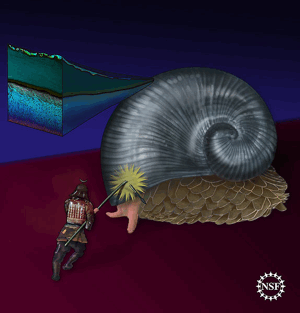Hard as Sea Snails
Air Date: Week of February 19, 2010

A soldier is deterred by the scaly-foot snail’s hard shell. (Image: Zina Deretsky, National Science Foundation)
Researchers believe that better body and vehicle armor could be modeled on the shell of the scaly-foot snail, a tiny gastropod that lives on the floor of the Indian Ocean. Emily Guerin reports.
Transcript
YOUNG: Coming up – an author finds deep insight by looking at the ways animals hide. But first this Note on Emerging Science from Emily Guerin.
[SCIENCE NOTE THEME]
GUERIN: The scaly-foot snail was only discovered in 2001, but the deep-sea dweller has already made a big splash in the scientific world. Its super-hard shell has MIT researchers wondering if armor could be modeled on the tiny creature.
The snail lives 6,000 feet under the sea next to “black smokers,” sea-floor chimneys that spew superheated water from under the earth’s crust. The little gastropod must tolerate pressure of up to 4,400 pounds per inch and acidic water that can range from near freezing to a piping hot 750 degrees Fahrenheit. To top it off, the scaly-foot must ward off attacks from crabs and other snails.

A soldier is deterred by the scaly-foot snail’s hard shell. (Image: Zina Deretsky, National Science Foundation)
But the scaly-foot has adapted to its unwelcoming home. It sports a tri-layered shell that can take a predator days to break through. The thin outer layer, made of iron sulfide, is the strongest. When attacked, it develops tiny cracks, dissipating the energy and preventing larger cracks from forming.
The middle layer is spongy and shock resistant like a bike helmet, and may also absorb heat. The inner layer is made of calcium carbonate, a common shell material that would erode in the acidic water if not protected by the other layers.
Scientists believe the tiny scaly-foot snail could teach them a lot about structural engineering, and may one day inspire a new generation of body and vehicle armor. It’s a lot of pressure to put on such a small creature, but pressure is one thing this snail is used to. That’s this week’s Note on Emerging Science. I’m Emily Guerin.
[SCIENCE NOTE THEME]
Links
Living on Earth wants to hear from you!
Living on Earth
62 Calef Highway, Suite 212
Lee, NH 03861
Telephone: 617-287-4121
E-mail: comments@loe.org
Newsletter [Click here]
Donate to Living on Earth!
Living on Earth is an independent media program and relies entirely on contributions from listeners and institutions supporting public service. Please donate now to preserve an independent environmental voice.
NewsletterLiving on Earth offers a weekly delivery of the show's rundown to your mailbox. Sign up for our newsletter today!
 Sailors For The Sea: Be the change you want to sea.
Sailors For The Sea: Be the change you want to sea.
 The Grantham Foundation for the Protection of the Environment: Committed to protecting and improving the health of the global environment.
The Grantham Foundation for the Protection of the Environment: Committed to protecting and improving the health of the global environment.
 Contribute to Living on Earth and receive, as our gift to you, an archival print of one of Mark Seth Lender's extraordinary wildlife photographs. Follow the link to see Mark's current collection of photographs.
Contribute to Living on Earth and receive, as our gift to you, an archival print of one of Mark Seth Lender's extraordinary wildlife photographs. Follow the link to see Mark's current collection of photographs.
 Buy a signed copy of Mark Seth Lender's book Smeagull the Seagull & support Living on Earth
Buy a signed copy of Mark Seth Lender's book Smeagull the Seagull & support Living on Earth

